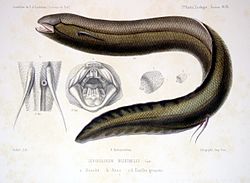South American lungfish
| South American lungfish | |
|---|---|
 |
|
| Scientific classification | |
| Kingdom: | Animalia |
| Phylum: | Chordata |
| Class: | Sarcopterygii |
| Subclass: | Dipnoi |
| Order: | Lepidosireniformes |
| Family: |
Lepidosirenidae Bonaparte, 1841 |
| Genus: |
Lepidosiren Fitzinger, 1837 |
| Species: | L. paradoxa |
| Binomial name | |
|
Lepidosiren paradoxa Fitzinger, 1837 |
|
The South American lungfish (Lepidosiren paradoxa) is the single species of lungfish found in swamps and slow-moving waters of the Amazon, Paraguay, and lower Paraná River basins in South America. Notable as an obligate air-breather, it is the sole member of its family Lepidosirenidae. Relatively little is known about the South American lungfish. Additional common names include American mud-fish and scaly . In Portuguese, it is also known as piramboia (Portuguese pronunciation: [piɾɐ̃ˈbɔj.jɐ]), pirarucu-bóia ([piɾɐɾuˈku ˈbɔj.jɐ]), traíra-bóia ([tɾɐˈiɾɐ ˈbɔj.jɐ]), and caramuru ([kɐɾɐmuˈɾu]).
The immature lungfish is spotted with gold on a black background; in the adult, this fades to a brown or gray color. Its tooth-bearing premaxillary and maxillary bones are fused as in all Dipnoi. South American lungfish also share an autostylic jaw suspension (where the palatoquadrate is fused to the cranium) and powerful adductor jaw muscles with the extant Dipnoi. Like the African lungfishes, this species has an elongated, almost eel-like body. It may reach a length of 125 cm (4.10 ft). The pectoral fins are thin and thread-like, while the pelvic fins are somewhat larger, and set far back. The fins are connected to the shoulder by a single bone, which is a marked difference from most fish, whose fins usually have at least four bones at their base; and a marked similarity with nearly all land-dwelling vertebrates. The gills are greatly reduced and essentially non-functional in the adults.
...
Wikipedia
